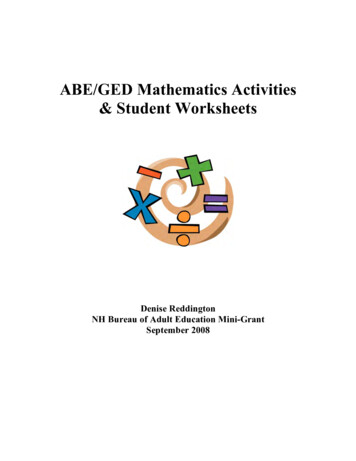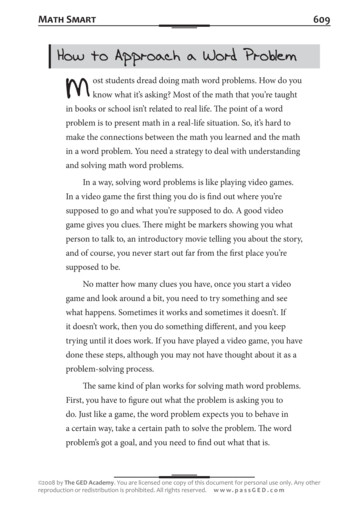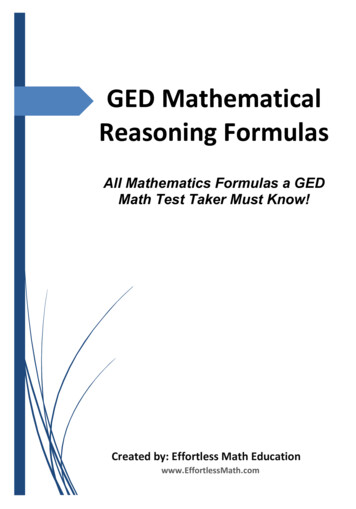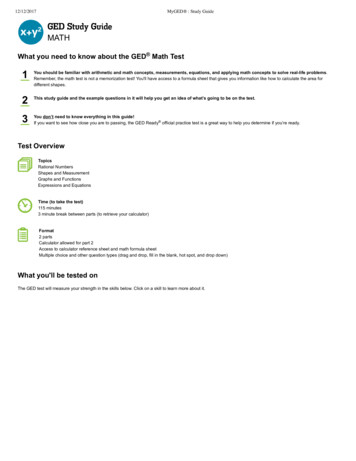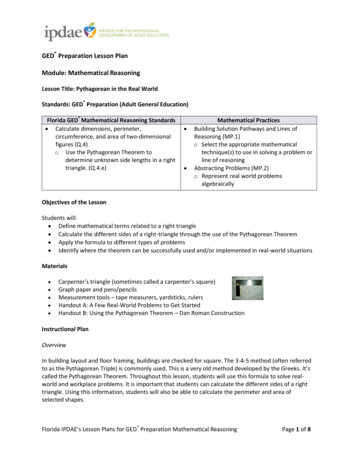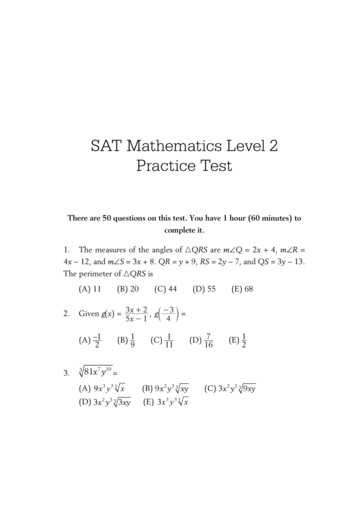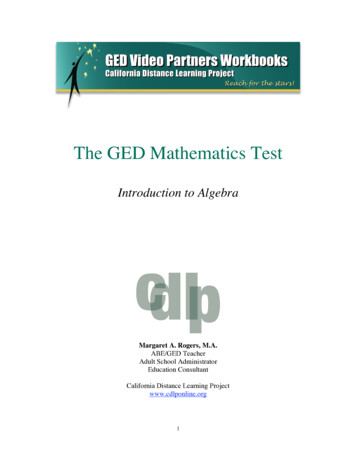
Transcription
The GED Mathematics TestIntroduction to AlgebraMargaret A. Rogers, M.A.ABE/GED TeacherAdult School AdministratorEducation ConsultantCalifornia Distance Learning Projectwww.cdlponline.org1
GEDVideo Partner#38 Passing the GED Math TestAlgebra and money are essentially levelers: the firstintellectually, the second effectively.Simone Weil (1909 - 1943)Video 38 Focus: how you use algebra to simplify equations and solve for variables.You Will Learn From Video 38:!!!!!How to use algebra to solve equations.How to simplify algebraic expressions.How to isolate variables as a rule for solving equations.The rules for operations with signed numbers.That algebra has a language of its own.Points to Remember: Words You Need to Know:While viewing the video, put the letter of the meaning by thecorrect vocabulary word.Answers are on page 21.1. signed numbers2. algebra3. variable4. equation5. inverse operationa. statement that two expressions areequalb. letters used to substitute fornumbersc. the set of positive and negativenumbersd. the opposite operation as additionis to subtraction and multiplication isto divisione. branch of mathematics2 Algebra is a branch ofmathematics that usesrules to strategicallysolve for variables.You need to knowsome basic rules ofalgebra for the GEDMath Test.Less than one-fourthof the GED Math Testmust be solved withalgebra.Some of the simpleproblems in algebracan be solved usingbasic arithmetic andlogical thinking.Algebra can be fun!
Introduction to AlgebraAlgebra is the branch of mathematics where the object is to use rules strategically to solve forvariables. Algebra has a symbolic language that is used to express relationships. Many of thesame rules and algorithms that we use in arithmetic we also use in algebra. However, in algebra,these rules are often used to solve equations. Equations are statements that two expressions areequal. An example of such an equation is:3 x 8 x 6In algebra, we are trying to find out which solution will make both sides of the equation equal.We are trying to balance the equation. There are many solutions to this equation. A solution willbe any number or expression that can fill the blank to make the right side of the equation equal tothe left. The simplest solution is the number 4. However, we could also fill the blank withexpressions such as (2 2) or (9 - 5). After we fill the blank we want to test to make sure thatboth sides of the equation are equal.3 x 8 x 63x8 4x624 24In algebra, letters are used to stand for unknown numbers. These letters are called variables. Avariable can stand for a single number or a complete expression. In the example above, we canreplace the blank line with a letter to stand for the variable answers.3x8 Ax6On the GED Math Test you will have to simplify equations, solve for variables, and useoperations with signed numbers. There are many other skills that are associated with thebranch of mathematics. However, if you are comfortable with these skills, you will be well onyour way to answering most of the algebra questions correctly.It is also important to understand the properties that allow you to manipulate an equation as yousimplify or solve for variables. In this Video Partners workbook, you will learn about andpractice with the following properties:"""Commutative properties of addition and multiplicationAssociative properties of addition and multiplicationDistributive property of multiplicationAlthough algebra is more abstract than arithmetic, it is important not to be afraid of it. Algebra isfull of step-by-step procedures. If you learn the steps one by one and then systematically applythem when you are simplifying or solving equations, you will be successful on the algebraquestions on the GED Math Test. And remember, there are only about 10 algebra questions outof the 50 questions on the GED Math Test.3
Balancing EquationsEquations are statements that two expressions are equal. In algebra, often some part of theequation is missing. The object of solving the equation is to discover what part(s) will balancethe equation and make the two sides equal to one another.Even though there are certain steps that are recommended to balance equations using the rules ofalgebra, it is often possible to balance equations just by using arithmetic skills. In this equation, itis easy to see that 4 is the only number that will make a true statement.3x8 Ax6Using your arithmetic skills, find one number which will balance each of the followingequations. Answers are on page 21.3 x 8 68 x 3 48 - 12 6 x 61,000 B104A 2425 a22 3x5 X-3(2 3)5 50/y 421/2 x 1/3 k/36.2 .2 %1 dozen b x 3VariablesA variable is a letter or symbol used to represent an unknown quantity in an equation orformula. The value of a variable can change. Sometimes the value is dependent on otherquantities and which quantities are known or unknown in the equation or formula. For example,the formula for finding the area of a rectangle is A LW. If the area is known to be 24, there areseveral solutions for L and W. If L 6, W 4. If L 8, W 3. The solution for one variable isdependent on the value of the other.Write at least three solutions for the variables in the following formulas:Answers are on page 21.A LWA 12A 1/2 BHA 24P 2L 2WP 36V LWHV 300Often there is a single solution for a variable. Find the solution for the missing value in theformulas below:A LWL 10, W 5A C !D4D 3C
Operations with Signed NumbersBefore using the basic rules of algebra to solve for variables, it is essential to know how toperform the four operations, addition, subtraction, multiplication, and division, with positive andnegative numbers. Positive numbers are those to the right of zero on the number line. Negativenumbers have values less than zero and are found to the left of zero on the number line.negativepositive -12 -11 -10 -9 -8 -7 -6 -5 -4 -3 -2 -1 0 1 2 3 4 5 6 7 8 9 10 11 12 Remember, the number line is a representation of all numbers even though there is not enoughspace to write all of the whole numbers, fractions, decimals, etc. They are all theoretically sittingin their proper place on the number line. Also, the number line is infinite. It extends in bothdirections with no end.Practice this exercise to review your understanding of the number line. Answers are on page 21.negativepositive -12 -11 -10 -9 -8 -7 -6 -5 -4 -3 -2 -1 0 1 2 3 4 5 6 7 8 9 10 11 12 On the number line above:a.b.c.d.e.circle zerodraw a box around -8add 4.5 in the correct placeput a star above -2add -1/2 in the correct placef. draw a triangle around 10g. add 7 3/4 in the correct placeh. add the next whole number to the left and righti. add - 2 1/2 in the correct placej. shade 9There are special rules to add, subtract, multiply, and divide signed numbers. These rules are notdifficult, but you must be able to perform these operations with confidence in order to succeed inalgebra.When solving algebraic equations, you must be able to move terms from one side of the equalssign to the other in order to isolate variables. In order to move terms, you will make use of therules for operations with signed numbers. You will also be using inverse operations as well.Inverse operations are the opposite operations. Addition and subtraction are opposites, andmultiplication and division are opposites. Later you will learn to eliminate terms using inverseoperations.However, before we follow the basic rules of algebra to solve equations, we must practice usingthe rules for operations with positive and negative numbers. Different math books explain therules in slightly different ways, but the result is always the same. Read and practice the rules foreach of the four operations, addition, subtraction, multiplication and division. When you find youare comfortable with these methods, then you will be ready for the basic rules of algebra.5
Operations with Signed ivisionThe RulesChecks and BillsChange the sign of the number being subtracted.Checks and BillsMultiply ignoring the signs.Give a sign to the answer: Like signs Unlike signs Divide ignoring the signs.Give a sign to the answer: Like signs Unlike signs -Addition - Checks and BillsOne way to think of the rules for adding signed (positive and negative) numbers is to just thinkof checks and bills. An illustration for checks and bills is found in postman stories.Although my father, who was born in 1908, clearly remembers when the mail was deliveredtwice a day, that has not been the case since the 1950s. There is now only one delivery each day;and yet we still use the phrase, “I’ll put it in the morning mail.” Every day is a new day whenanalyzing postman stories.Answers are on page 21.MondayOn Monday the postman brought two checks, one for 56.00 and one for 10.00. Assuming youhave no other money in the world, what is your financial situation after this delivery?TuesdayOn Tuesday, the postman brought a check for 25.00 and a bill for 13.00. Assuming you haveno other money in the world, what is your financial situation after this delivery?WednesdayOn Wednesday, the postman brought two bills. One was for 68.50, and the other was for 16.00. Assuming you have no other money in the world, what is your financial situation afterthis delivery?ThursdayOn Thursday, the postman brought two checks and one bill. The checks were for 24.75 and 34.00. The bill was for 100.00. Assuming you have no other money in the world, what is yourfinancial situation after this delivery?6
FridayOn Friday, the postman brought three checks and one bill. The checks were for 14.00, 39.50,and 45.00. The bill was for 64.00. Assuming you have no other money in the world, what isyour financial situation after this delivery?SaturdayOn Saturday, the postman brought only bills. Alas, there were three of them. There was anelectric bill for 44.50, a magazine subscription for 24.95, and a parking ticket for 6.00.Assuming you have no other money in the world, what is your financial situation after thisdelivery?There are no mail deliveries on Sunday.Challenge problem: If every day were not a new day, how much money would you have or oweat the end of the week?As adults experienced with money, we may have used different ways to arrive at the total eachday. No matter what we did, including subtraction, we were still adding signed numbers as wecompleted this exercise. Continue to practice with some numerical problems:Add (Checks and Bills):Note: Any number without a sign is positive (a check). 36- 5- 8-17 100- 25-100 25 32-176040-40-60 81-36 3-7 8-2( 17) ( 5) (-6) (-2) 15 12 (-17) ( 8) (-75) (-8) During the holiday mail season, bills were mounting up for Carrie. She had placed many catalogorders that were arriving C.O.D. She kept her checkbook right by the front door so she would beready to settle the bills and accept the items. On December 10th, she received C.O.D. orders for 12.64, 39.57, and 19.11. She wrote checks for all of them. The same day, she received a giftcheck for 50.00 from her Aunt Tilda. Did she spend more or come out ahead that day? Howmuch?7
SubtractionThe rules for subtracting signed numbers are completed in two steps:1. Change the sign of the number being subtracted.2. Add (Checks and Bills)When you are subtracting (-4) from ( 16), you would first change the sign of the number beingsubtracted (-4). Then add (checks and bills). In this case, you now have two checks.Subtract: 16- 4Subtract: 16 4 20Answers are on page 22.-12 3 16-5 38 2 19-6-37 5-85-50 8-3 3-8 50-275-60-7560-75-60( 6) - (-9) - ( 3) - ( 7) (-6) - ( 9) - (30) - (-7) MultiplicationThe rules for multiplying signed numbers are completed in two steps:1. Multiply ignoring the signs.2. Give a sign to the answer: Like signs Multiply:Unlike signs -Answers are on page 22.(8) (-3)(-3) (-5)( 5) (-11)( 5) (-3)(-2) (-12)( 3) (-5)( 6) ( 8)(-10) (-10)(-7) ( 9)(-20) ( 5)(-5) (20)(-9) ( 6)8
DivisionThe rules for dividing signed numbers are the same as multiplication and are completed in twosteps:1. Divide ignoring the signs.2. Give a sign to the answer:Divide:Like signs Unlike signs -Answers are on page 22.( 48) (-12)(-25) (-5)-10-2-76 4( 36) (-6) 64 8(-24) ( 6) 50-25 366-6Mixed PracticeAddSubtractMultiplySubtractAddAdd-16 4 12-7 50 8 38-6-17 5-12-50Subtract12-12(-35) (-7)(-2) ( 15)(-5) (10)(-18) ( 6)35/-7(-100) (-20)( 50) (-10)( 9) (-7)50 (-3)-100/4Measure UpCalculator PermittedAn acre-foot is a measurement used for irrigation water. It is the amount of water that wouldcover an acre of land one foot deep. An acre is equal to 160 square rods. A square rod is equal to30.25 square yards. Practice your unit conversion skills by answering the following questions.Answers are on page 22.How many square yards of water one foot deep are in two acre-feet?How many square feet of water one foot deep are in an acre-foot?9
Properties of OperationsCommutative Property of Addition and MultiplicationThe commutative property is a law in mathematics that states that the order in which you addor multiply numbers does not affect the result; for example, 3 4 4 3. In algebra you will usethe commutative property.a b b aab baAssociative Property of Addition and MultiplicationThe associative property is a law in mathematics that states that when you add or multiply morethan two numbers, you can group the numbers in any order without affecting the result; forexample 3 (4 5) (3 4) 5. You will use the associative property in algebra.a (b c) (a b) ca(bc) (ab)cDistributive Property of MultiplicationThe distributive property is a law in mathematics that states when a number is multiplied by asum written in parentheses, you can find the result by multiplying the number outside theparentheses by each number in the parentheses and then adding. In other words, you aredistributing the multiplier across all of the terms; for example, 4 x (5 6) 4 x 5 4 x 6 20 24 44. You will use the distributive property in algebra.a(b c) ab acPractice identifying the law of mathematics that is used in each of the following expressions.Write commutative, associative, or distributive after each expression to show which law ismodeled by the expression.Answers are on page 22.12 13 13 125(c d) 5c 5d10 x 6 6 x 10x(yz) (xy)z10 (8 9) (10 8) 9(2 x 3) (2 x 4) 2 (3 4)xy yx4 10 10 410
About Math and LifeMarina was excited about her new home business to wrap gifts and make giftbaskets. She knew starting a new business would require patience. She had to domarketing and recruit a group of returning customers. She was prepared to have only a smallprofit or even take a loss the first year. She set up a spreadsheet to track her expenses andincome. Working with this type of spreadsheet is like adding positive and negative numbers. Youcan think of the income as checks and the expenses as bills. Marina’s spreadsheet appears below.Excel WorksheetGifts by Marina 54600002050250300994ExpensesPaperTape Ribbon Office Cards Baskets Total150103575100 3006701601601616253351051751002550325896How much of a profit or loss did Marina show during the first year of her business?Explain whether or not she met her goals and why.Do you think that Marina will continue her business during the following year. Why or why notAnswers are on page 22.11
Isolating Variables and Solving for UnknownsAn equation is a mathematical statement that two expressions are equal. Look at theequation below:3x 5 35This equations states that 3x 5 is equal to 35. In order to solve the equation, you must find thevalue for the variable, x, that will make the equation true. Since an equation is like a balancescale, you can add or subtract the same quantity on both sides of the equation without upsettingthe balance. You can also multiply or divide by the same quantity on both sides of the equationwithout upsetting the balance. Remember that whatever you do on one side of the equation, youmust do on the other side to maintain the balance.Isolating VariablesTo solve an equation, you must first isolate the variable. In the equation above, the variable, x, ispart of the term 3x. So you want to isolate that term on the left side of the equals sign. In order toisolate that term, you must eliminate the other term, 5. To eliminate terms, use the inverseoperation. An inverse operation is the opposite operation. Addition and subtraction are oppositesMultiplication and division are opposites. Subtract 5 from the left side to eliminate the 5.Remember, you also must subtract 5 from the other side.3x 5 35- 5 35 - 53x 30Now the term with the variable, x, is isolated on the left side of the equals sign. In order tosolve for the value of x, now eliminate the 3 from the term 3x by using the inverse operation ofmultiplication. Divide by 3. Then you must divide the right side by 3 as well.3x 3033x 10Substitute 10 into the original equation to check you answer.3x 5 353(10) 5 3530 5 3535 3512
Solving for UnknownsPractice these steps to solve for the unknown in the following equations:a. Use inverse operations to eliminate terms without variables (remember to keep theequation in balance by performing the same operation on both sides of the equalssign).b. Isolate the term with the variable on one side of the equals sign.c. Use inverse operations to eliminate numbers from the term with the variable leavingjust the letter by itself (remember to keep the equation in balance by performing thesame operation on both sides of the equals sign).d. After finding the value of the variable, plug it into the equation to check your work.2x 8 30a. 2x 8 302x - 8 30 - 8b. 2x 22c. 2x 2222x 11d. 2x 8 302(11) 8 3022 8 3030 30Exercise:Answers are on page 22.x 5 20a - 12 485 10060/y 122x - 8 322y - 6 225 3y - 284q 4820 5 10x16 - z 12x 25 10048 2 72Measure Up - It’s Just a Matter of Time120 seconds minutesminutes 3 hours1 day hours1 century years3 decades years2 years daysweeks 2 years3 weeks days3 days hours36 months years40 minutes hour3 months year13
Combining Like TermsSometimes an equation will contain terms that should be combined before solving the equation.Any like terms can be combined to simplify the process of solving the equation. In the equationbelow, there are examples of like terms that can be combined.3x 6 -12 4 -x 16Before solving this equation, you can combine the terms that contain the variable, x. These arelike terms because they contain the same variable. Remembering the rules for signed numbers,we know that 3x (-x) 2x.2x 6 -12 4 16Now you can combine the numerical terms that are on the same side of the equals sign. In thisequation, the two positive numbers can be combined to make 10. Add 10 to -12, and you areleft with -2.2x - 2 16Now solve the equation using the steps on page 13.Answer is on page 23.Practice by combining like terms in the following expressions. Answers are on page 23.5t - 6 2t 32xy - xy 13 3x x 5 7 4x26 - 35 c 5c 1003(2x - 4) 6 - 2x15" 16 " - 12Now practice solving more complex equations by combining like terms and then following theother rules:""""Combine like terms on each side of the equals sign.Isolate the term with the variable on one side of the equals sign.Use inverse operations to solve for the variable.Check your answer.12x 13 746x 7 37x x 5 2x 258y - 4y 12 338(k - 3) 5k 35z 4z - 10 3514
Out into Space33Circle Up3Write four 1’s and three 2’s in the circles so that no three numbers that are next to each otherhave a
On the GED Math Test you will have to simplify equations , solve for variables , and use operations with signed numbers . There are many other skills that are associated with the . the formula for finding the area of a rectangle is A LW. If the area is known to be 24, there are several solutions for L and W. If L 6, W 4. If L 8, W 3.File Size: 1MB

